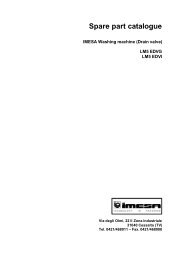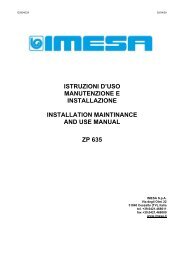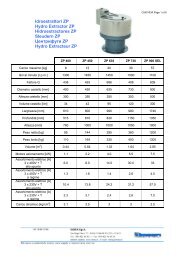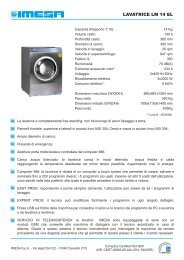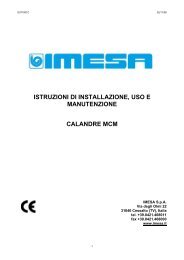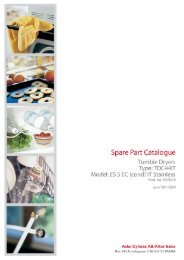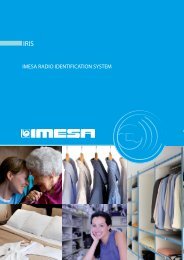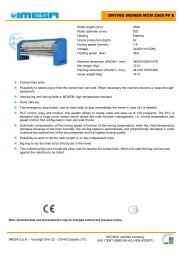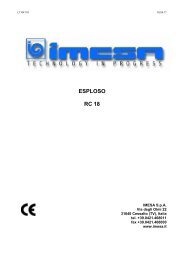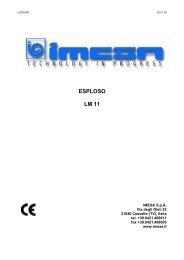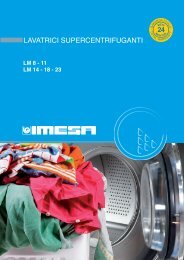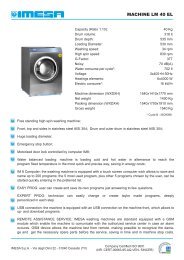S/EP1 - S/EP3 S/EP4 - S/EP5 - IMESA SpA
S/EP1 - S/EP3 S/EP4 - S/EP5 - IMESA SpA
S/EP1 - S/EP3 S/EP4 - S/EP5 - IMESA SpA
You also want an ePaper? Increase the reach of your titles
YUMPU automatically turns print PDFs into web optimized ePapers that Google loves.
13<br />
The machine is normally despatched in a carton<br />
packing crate on wooden pallet, fixed in such a way<br />
that it cannot move.<br />
4.2 LIFTING OF THE MACHINE<br />
For the installation of the machine, it is necessary to<br />
arrange a lifting device able to lift the loads indicated in<br />
the technical details.<br />
To lift the machine, use the two belts, as indicated in<br />
tav.B.<br />
4.3 UNLOADING AND POSITIONING<br />
After unloading the machine, remove the carton<br />
packing, and position the machine on a perfectly flat<br />
surface in a working environment with the following<br />
characteristics:<br />
• the floor must be able to bear the weight of the<br />
machine;<br />
• the walls must be at least 0.5 Mtrs at the sides<br />
and 1 mtr. at the back, away from the machine;<br />
• it must be sufficiently aired; the installation of a<br />
conditioning system to be activated during use of<br />
the machine is recommended.<br />
It is recommended to check the condition and quality of<br />
the machine.<br />
4.4 ELECTRICAL CONNECTION<br />
ATTENTOIN: If the line to which the machine is<br />
connected is a system of the type “TN-C” (neutral<br />
also acts as a protective conductor, there fore the<br />
neutral and protective functions are combined in a<br />
single conductor called PEN), the A connection<br />
should be made on the terminal box between the N<br />
and PE terminals by means of a unipolar yellowgreen<br />
cable with the same section as the line<br />
conductors.<br />
A<br />
PE U V W N<br />
LINE<br />
WARNING: Before making any electrical connection,<br />
check that the main switch (tav.01-ref.1) is off “O”.<br />
After positioning the machine, connect by means of an<br />
electric cable maximum length 5 mtrs and a suitable<br />
cable guide, to the machine terminal box.<br />
For longer cable lengths consult technical service or<br />
specialised service engineers.<br />
The feed cable must be protected by a magnetothermal<br />
switch.<br />
The electrical system to which the machine is<br />
connected must be provided with a highly sensitive<br />
differential switch, to ensure a suitable safety level and<br />
the earthing system must be in conformity with national<br />
regulations in the user’s nation (with in Europe in<br />
conformity with IEC 364).<br />
Make sure that the feed voltage/frequency corresponds<br />
to the description on the machine plate.<br />
Tolerance of feed oscillation:<br />
± 10% for nominal voltage<br />
± 1% for nominal frequency<br />
Beyond the above values, the machine could get<br />
damaged. Therefore, in cases where the local electricity<br />
supply could exceed the above limits, the user must<br />
arrange at his own expense, to stabilize the line voltage<br />
to the machine.<br />
Carefully follow the instructions on the attached wiring<br />
diagram.<br />
Installation of said protection is at the expense of the<br />
user, who is responsible for correct installation.<br />
Connection of the cable to the machine is carried out as<br />
follows:<br />
• put the main switch (tav.01-ref.1) on “O” position;<br />
• open the panel;<br />
• connect the wires of the feed cable to the terminals<br />
(do not use the yellow/green wire for this<br />
connection);<br />
• the Yellow/green wire must be connected to the<br />
machine PE terminal.<br />
The other end of the yellow/green wire of the cable must<br />
be connected to the earthing system which must be in<br />
conformity with national regulations in the user’s country.<br />
The main switch (tav.01-ref.1) also acts as an<br />
emergency stop; if necessary, turn the red handle to the<br />
“O” position, thereby acting on the main supply to the<br />
machine, which will be disconnected.<br />
4.5 HYDRAULIC CONNECTION<br />
Connect the fitting (ref.30) as follows:<br />
• At about 50 cms from the machine attach a 3/8”pipe<br />
to the water supply.<br />
• On the end of the pipe mount a tap with a 3/8” fitting.<br />
• Connect the two fittings by means of a pressure<br />
hose (max 12 atm) with a diameter of 12 mm,<br />
blocking the fittings with two clamps.<br />
• Connect the boiler drain tap (ref.22) by means of a<br />
pressure hose, if possible to a drain.<br />
If direct connection is impossible, position a container<br />
able to hold at least 20 litres near the machine and<br />
ensure that it never gets empty.<br />
CHARACTERISTICS OF FEED WATER<br />
The efficiency of the generator, its reliability and<br />
durability, depend for the most part on the condition of<br />
the internal surfaces and consequently on the feed<br />
water, which should have the following characteristics:<br />
- clear, transparent looking with no persistent foaming;<br />
- total hardness mg/l CaCOз < 5;<br />
- PH at 25°C of 7,5÷9,5.<br />
4.6 COMPRESSED AIR CONNECTION<br />
Connect the machine to the fitting (ref.25) with a<br />
compressed air line of at least 100 ltrs/min capacity at 6<br />
bar.<br />
It is advisable for a stop tap to be fitted.<br />
4.7 AIR DISCHARGE CONNECTION<br />
By means of the vacuum (ref.39) the excess steam<br />
produced during pressing is expelled.<br />
Should this issue of steam prove to be troublesome, this<br />
can be channelled towards the outside by means of a



